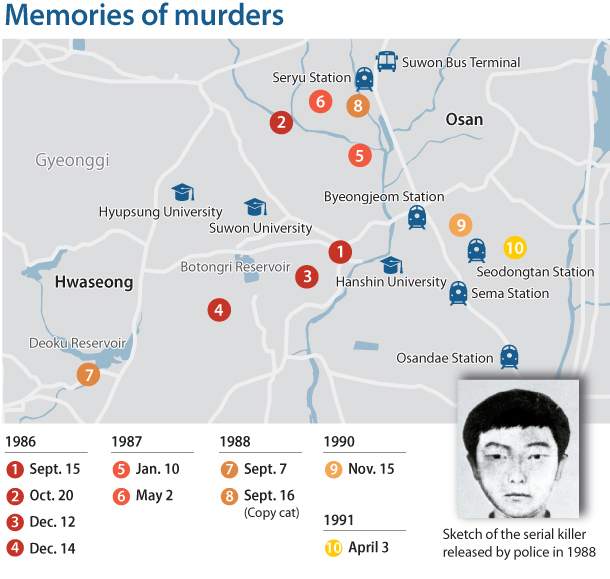DNA may have solved 1980s homicide spree

According to Ban Ki-soo, a chief investigator at the Gyeonggi Nambu Provincial Police Agency on Thursday, newly analyzed DNA evidence from three of the nine cases matched the DNA of a 56-year-old convict surnamed Lee currently serving a life sentence in Busan for a different murder he committed in 1994.
This discovery could very well bring a resolution to one of the most notorious serial rape and murder sprees in Korean criminal history, which terrified Korea from 1986 to 1991 and remained unsolved for three decades.
Yet the suspect, who was in his 20s at the time of the killings, can no longer be charged for any of those crimes since the statute of limitations for the last of the murders expired in April 2006. He has denied responsibility for all nine murders, police said.
Lee is serving a life sentence in the Busan Penitentiary for raping and murdering his wife’s sister, aged 20 at his home in Cheongju, North Chungcheong, in January 1994. According to press reports, he is a model prisoner with a taciturn personality who is eligible for parole.
A 10-victim rape and murder spree of the late 1980s and early 1990s terrified the nation - particularly due to the authorities’ inability to find a culprit - and was compared to the so-called Zodiac killings in California in the late 1960s. The killings gave rise to copycat crimes and inspired one of the most iconic blockbusters of Korean cinema, “Memories of Murder.”
From 1986 to 1991, 10 women were murdered in rural counties in Hwaseong, all within approximately 3 kilometers (1.9 miles) of each other.
The first of those grisly homicides involved a 71-year-old woman, who was found in a field of grass on Sept. 19, 1986, bound, stripped of her lower clothing and strangled. Over the next three months, three other women were found dead, all in their 20s. All were apparently raped before they were choked to death.
In the following year, there were two more rape and murder cases, in January and May 1987. The victims were women aged 18 and 29.
The next two murders took place almost back-to-back over a year later in September 1988. One of the victims was a 54-year-old woman slain in the same fashion, while the other was a 13-year-old middle schooler, apparently murdered in her sleep in her home, very different circumstances from the other killings. A 22-year-old man surnamed Yoon was arrested in July 1989, but police deemed it unlikely that he was responsible for the cases before the killing of the 13-year-old. Yoon was convicted of the single murder of the young girl.
Definitive confirmation that Yoon wasn’t the serial killer came with two more murders that took place after a gap of two years. The ninth victim - a 14-year-old girl - was found bound, raped and strangled in November 1990, this time with wounds on her body apparently inflicted by a variety of objects like a fork, spoon, pen and razor.
Five months later, in April 1991, the killer took what appeared to be his final victim: a 69-year-old woman.
Authorities mounted the largest criminal investigation in Korean history, mobilizing close to two million police personnel. Around 3,000 suspects were questioned.
But the murderer was never found.
A big part of the problem was the unprofessional methodology of investigators at the time and the absence of technology and equipment to mount a modern forensic criminal analysis. Despite the fact that the killer left ample amounts of evidence at the scenes of the crimes - from smoked cigarette butts to hair and sperm samples - many of these items were discarded or lost in the investigation. Police at the time were unfamiliar with proper evidence collection methods.
According to Ban, what prompted the police to try something new was the discovery that the latest forensics technology could extract and break down DNA samples from decades-old evidence - victims’ clothing from decades ago, which had been kept.
Starting from July 15, police sent three pieces of DNA collected from clothing on the fifth, seventh and ninth victims, who were killed in 1987, 1988 and 1990 respectively, to the National Forensic Service, which had access to a vast police database of incarcerated criminals.
That led them to Lee.
While further prosecution of Lee is no longer viable, police say they will continue their efforts to shed light on the crimes.
“The principles enshrined in criminal law state that while there is meaning behind punishment for the culprit, there is also [significance] behind uncovering the truth [behind unresolved criminal cases],” Ban said at a press conference on Thursday. “We will focus on this aspect.”
BY SHIM KYU-SEOK [shim.kyuseok@joongang.co.kr]










with the Korea JoongAng Daily
To write comments, please log in to one of the accounts.
Standards Board Policy (0/250자)